Analysis of Pathophysiology and Pharmacology in Nursing Practice 3
VerifiedAdded on 2022/12/26
|12
|2928
|28
Report
AI Summary
This report provides a comprehensive analysis of a nursing case study involving a patient experiencing heart failure. The introduction highlights the roles of nurses in patient care, emphasizing the application of pathophysiology and pharmacology. The main body delves into the rationale for ECG and blood tests, the pathophysiology of heart failure, and ECG analysis. It discusses the importance of understanding heart function and the causes of heart failure, including systolic and diastolic dysfunction. The report also examines the patient's symptoms, progression of the condition, and the causes of shortness of breath. Furthermore, it explores the pharmacology of medications like Atenolol and Furosemide, including their mechanisms of action, complications, and nursing considerations. Medication non-adherence is discussed, with factors influencing patient compliance. The conclusion summarizes the nurse's responsibilities in providing holistic patient care, emphasizing the importance of clinical scenarios and management practices in heart failure cases. The references section provides a list of sources used to support the analysis.
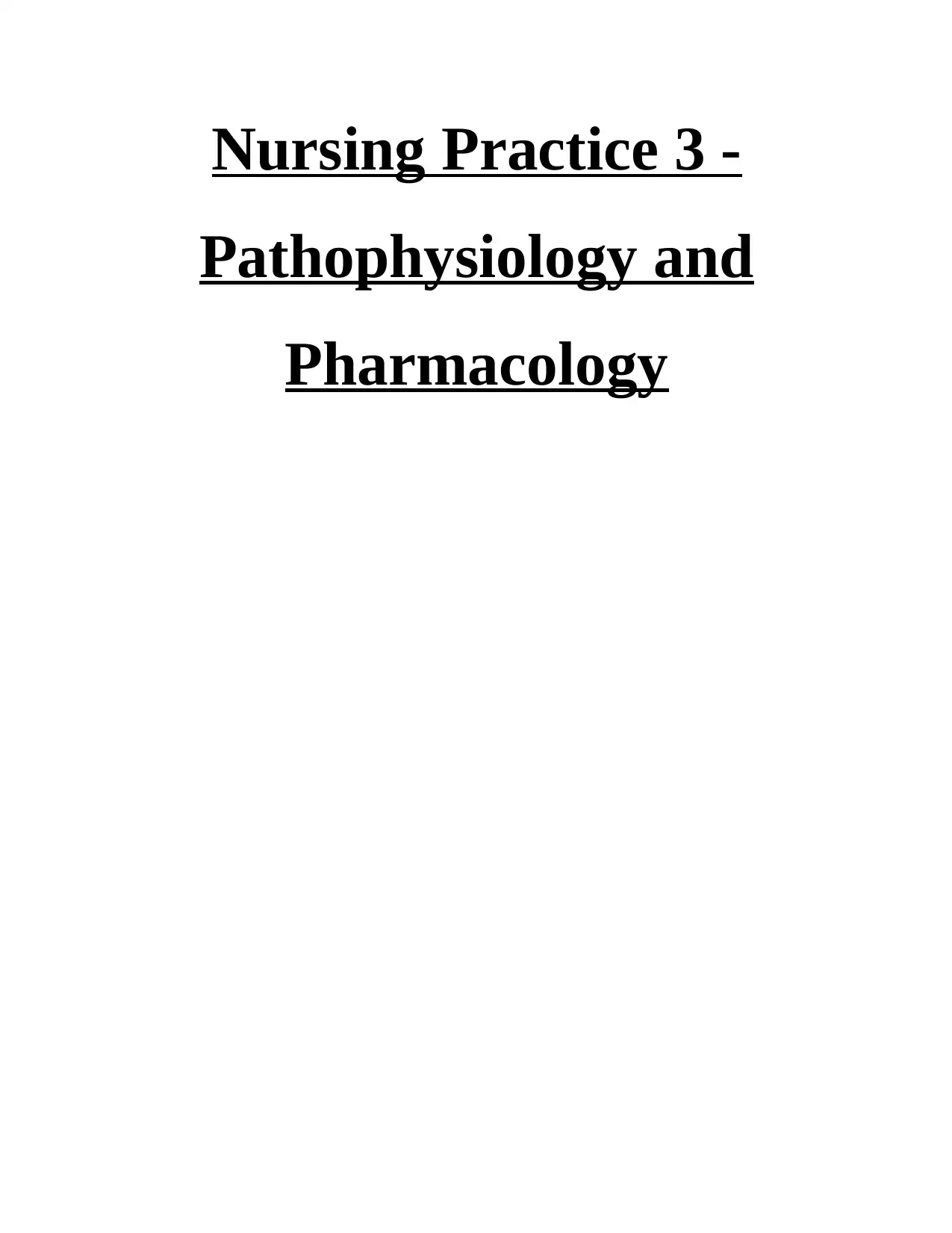
Nursing Practice 3 -
Pathophysiology and
Pharmacology
Pathophysiology and
Pharmacology
Paraphrase This Document
Need a fresh take? Get an instant paraphrase of this document with our AI Paraphraser
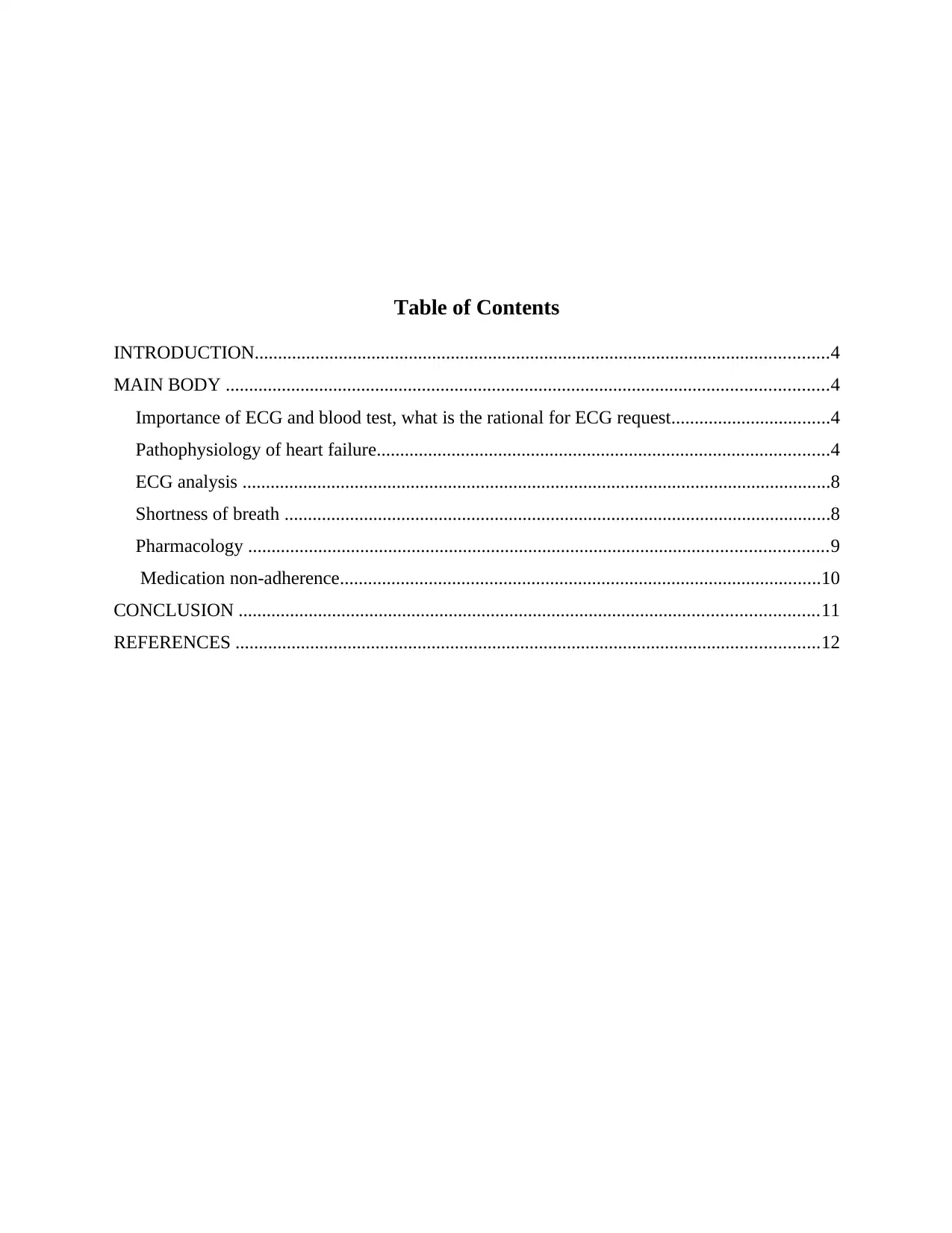
Table of Contents
INTRODUCTION...........................................................................................................................4
MAIN BODY .................................................................................................................................4
Importance of ECG and blood test, what is the rational for ECG request..................................4
Pathophysiology of heart failure.................................................................................................4
ECG analysis ..............................................................................................................................8
Shortness of breath .....................................................................................................................8
Pharmacology ............................................................................................................................9
Medication non-adherence.......................................................................................................10
CONCLUSION ............................................................................................................................11
REFERENCES .............................................................................................................................12
INTRODUCTION...........................................................................................................................4
MAIN BODY .................................................................................................................................4
Importance of ECG and blood test, what is the rational for ECG request..................................4
Pathophysiology of heart failure.................................................................................................4
ECG analysis ..............................................................................................................................8
Shortness of breath .....................................................................................................................8
Pharmacology ............................................................................................................................9
Medication non-adherence.......................................................................................................10
CONCLUSION ............................................................................................................................11
REFERENCES .............................................................................................................................12

⊘ This is a preview!⊘
Do you want full access?
Subscribe today to unlock all pages.

Trusted by 1+ million students worldwide
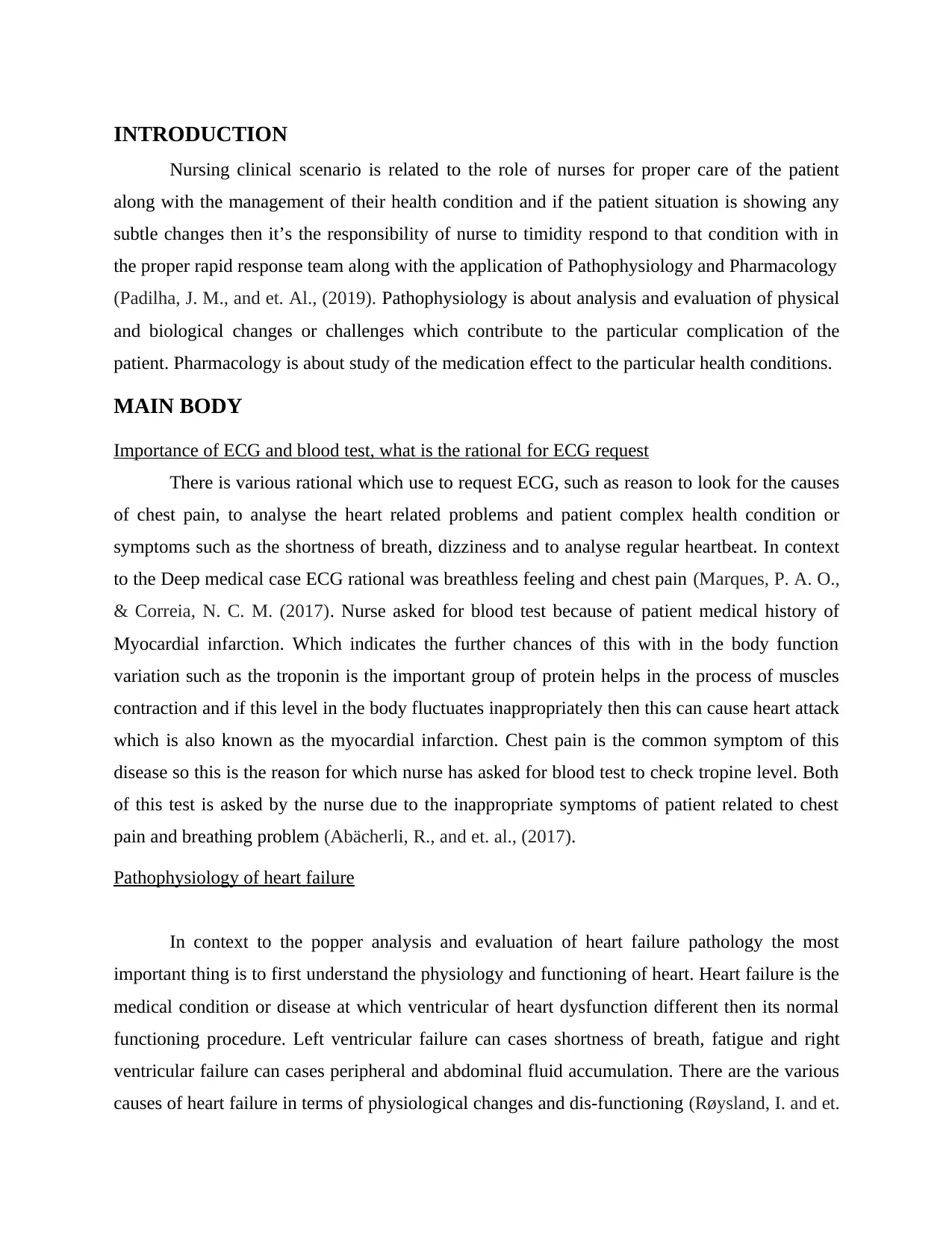
INTRODUCTION
Nursing clinical scenario is related to the role of nurses for proper care of the patient
along with the management of their health condition and if the patient situation is showing any
subtle changes then it’s the responsibility of nurse to timidity respond to that condition with in
the proper rapid response team along with the application of Pathophysiology and Pharmacology
(Padilha, J. M., and et. Al., (2019). Pathophysiology is about analysis and evaluation of physical
and biological changes or challenges which contribute to the particular complication of the
patient. Pharmacology is about study of the medication effect to the particular health conditions.
MAIN BODY
Importance of ECG and blood test, what is the rational for ECG request
There is various rational which use to request ECG, such as reason to look for the causes
of chest pain, to analyse the heart related problems and patient complex health condition or
symptoms such as the shortness of breath, dizziness and to analyse regular heartbeat. In context
to the Deep medical case ECG rational was breathless feeling and chest pain (Marques, P. A. O.,
& Correia, N. C. M. (2017). Nurse asked for blood test because of patient medical history of
Myocardial infarction. Which indicates the further chances of this with in the body function
variation such as the troponin is the important group of protein helps in the process of muscles
contraction and if this level in the body fluctuates inappropriately then this can cause heart attack
which is also known as the myocardial infarction. Chest pain is the common symptom of this
disease so this is the reason for which nurse has asked for blood test to check tropine level. Both
of this test is asked by the nurse due to the inappropriate symptoms of patient related to chest
pain and breathing problem (Abächerli, R., and et. al., (2017).
Pathophysiology of heart failure
In context to the popper analysis and evaluation of heart failure pathology the most
important thing is to first understand the physiology and functioning of heart. Heart failure is the
medical condition or disease at which ventricular of heart dysfunction different then its normal
functioning procedure. Left ventricular failure can cases shortness of breath, fatigue and right
ventricular failure can cases peripheral and abdominal fluid accumulation. There are the various
causes of heart failure in terms of physiological changes and dis-functioning (Røysland, I. and et.
Nursing clinical scenario is related to the role of nurses for proper care of the patient
along with the management of their health condition and if the patient situation is showing any
subtle changes then it’s the responsibility of nurse to timidity respond to that condition with in
the proper rapid response team along with the application of Pathophysiology and Pharmacology
(Padilha, J. M., and et. Al., (2019). Pathophysiology is about analysis and evaluation of physical
and biological changes or challenges which contribute to the particular complication of the
patient. Pharmacology is about study of the medication effect to the particular health conditions.
MAIN BODY
Importance of ECG and blood test, what is the rational for ECG request
There is various rational which use to request ECG, such as reason to look for the causes
of chest pain, to analyse the heart related problems and patient complex health condition or
symptoms such as the shortness of breath, dizziness and to analyse regular heartbeat. In context
to the Deep medical case ECG rational was breathless feeling and chest pain (Marques, P. A. O.,
& Correia, N. C. M. (2017). Nurse asked for blood test because of patient medical history of
Myocardial infarction. Which indicates the further chances of this with in the body function
variation such as the troponin is the important group of protein helps in the process of muscles
contraction and if this level in the body fluctuates inappropriately then this can cause heart attack
which is also known as the myocardial infarction. Chest pain is the common symptom of this
disease so this is the reason for which nurse has asked for blood test to check tropine level. Both
of this test is asked by the nurse due to the inappropriate symptoms of patient related to chest
pain and breathing problem (Abächerli, R., and et. al., (2017).
Pathophysiology of heart failure
In context to the popper analysis and evaluation of heart failure pathology the most
important thing is to first understand the physiology and functioning of heart. Heart failure is the
medical condition or disease at which ventricular of heart dysfunction different then its normal
functioning procedure. Left ventricular failure can cases shortness of breath, fatigue and right
ventricular failure can cases peripheral and abdominal fluid accumulation. There are the various
causes of heart failure in terms of physiological changes and dis-functioning (Røysland, I. and et.
Paraphrase This Document
Need a fresh take? Get an instant paraphrase of this document with our AI Paraphraser
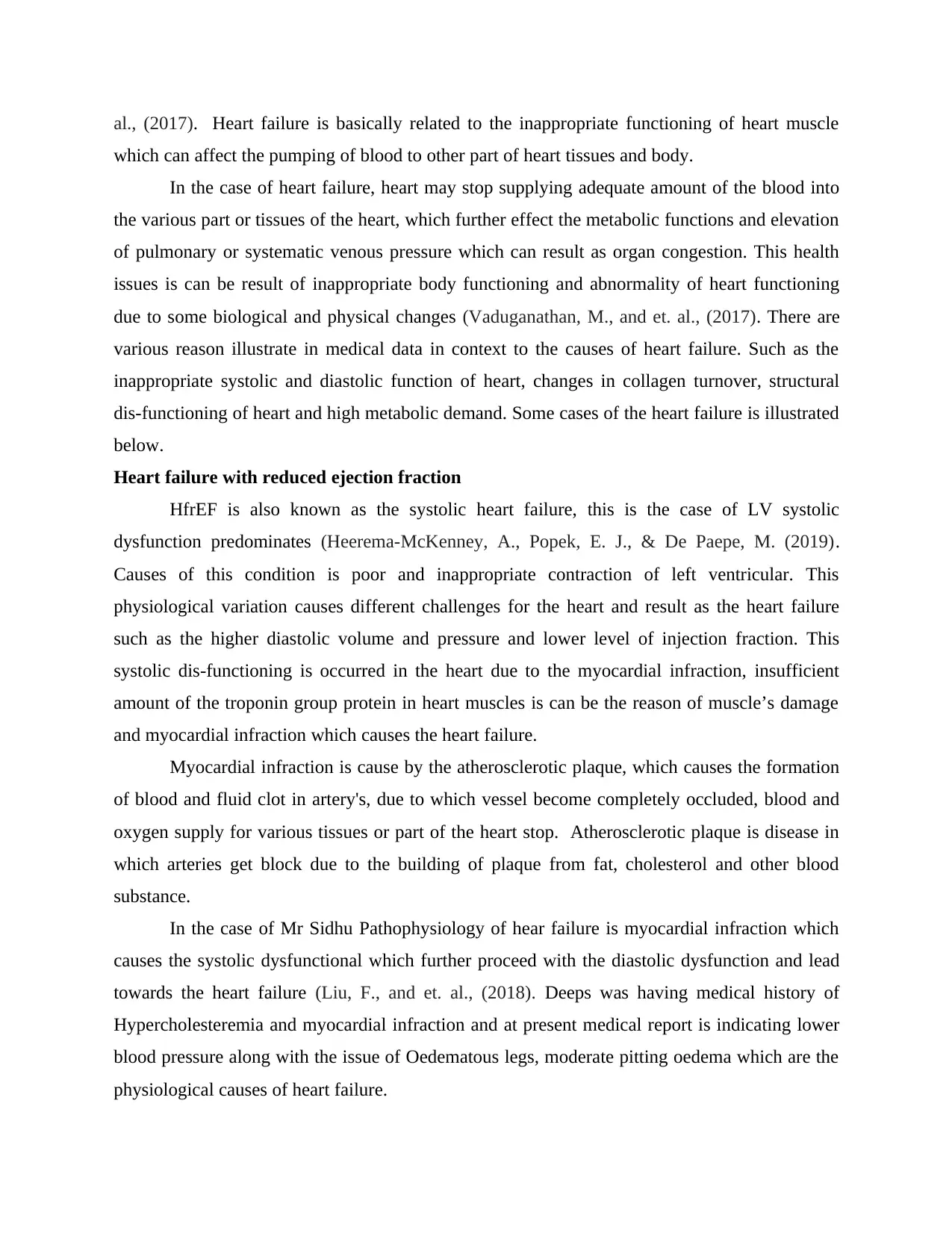
al., (2017). Heart failure is basically related to the inappropriate functioning of heart muscle
which can affect the pumping of blood to other part of heart tissues and body.
In the case of heart failure, heart may stop supplying adequate amount of the blood into
the various part or tissues of the heart, which further effect the metabolic functions and elevation
of pulmonary or systematic venous pressure which can result as organ congestion. This health
issues is can be result of inappropriate body functioning and abnormality of heart functioning
due to some biological and physical changes (Vaduganathan, M., and et. al., (2017). There are
various reason illustrate in medical data in context to the causes of heart failure. Such as the
inappropriate systolic and diastolic function of heart, changes in collagen turnover, structural
dis-functioning of heart and high metabolic demand. Some cases of the heart failure is illustrated
below.
Heart failure with reduced ejection fraction
HfrEF is also known as the systolic heart failure, this is the case of LV systolic
dysfunction predominates (Heerema-McKenney, A., Popek, E. J., & De Paepe, M. (2019).
Causes of this condition is poor and inappropriate contraction of left ventricular. This
physiological variation causes different challenges for the heart and result as the heart failure
such as the higher diastolic volume and pressure and lower level of injection fraction. This
systolic dis-functioning is occurred in the heart due to the myocardial infraction, insufficient
amount of the troponin group protein in heart muscles is can be the reason of muscle’s damage
and myocardial infraction which causes the heart failure.
Myocardial infraction is cause by the atherosclerotic plaque, which causes the formation
of blood and fluid clot in artery's, due to which vessel become completely occluded, blood and
oxygen supply for various tissues or part of the heart stop. Atherosclerotic plaque is disease in
which arteries get block due to the building of plaque from fat, cholesterol and other blood
substance.
In the case of Mr Sidhu Pathophysiology of hear failure is myocardial infraction which
causes the systolic dysfunctional which further proceed with the diastolic dysfunction and lead
towards the heart failure (Liu, F., and et. al., (2018). Deeps was having medical history of
Hypercholesteremia and myocardial infraction and at present medical report is indicating lower
blood pressure along with the issue of Oedematous legs, moderate pitting oedema which are the
physiological causes of heart failure.
which can affect the pumping of blood to other part of heart tissues and body.
In the case of heart failure, heart may stop supplying adequate amount of the blood into
the various part or tissues of the heart, which further effect the metabolic functions and elevation
of pulmonary or systematic venous pressure which can result as organ congestion. This health
issues is can be result of inappropriate body functioning and abnormality of heart functioning
due to some biological and physical changes (Vaduganathan, M., and et. al., (2017). There are
various reason illustrate in medical data in context to the causes of heart failure. Such as the
inappropriate systolic and diastolic function of heart, changes in collagen turnover, structural
dis-functioning of heart and high metabolic demand. Some cases of the heart failure is illustrated
below.
Heart failure with reduced ejection fraction
HfrEF is also known as the systolic heart failure, this is the case of LV systolic
dysfunction predominates (Heerema-McKenney, A., Popek, E. J., & De Paepe, M. (2019).
Causes of this condition is poor and inappropriate contraction of left ventricular. This
physiological variation causes different challenges for the heart and result as the heart failure
such as the higher diastolic volume and pressure and lower level of injection fraction. This
systolic dis-functioning is occurred in the heart due to the myocardial infraction, insufficient
amount of the troponin group protein in heart muscles is can be the reason of muscle’s damage
and myocardial infraction which causes the heart failure.
Myocardial infraction is cause by the atherosclerotic plaque, which causes the formation
of blood and fluid clot in artery's, due to which vessel become completely occluded, blood and
oxygen supply for various tissues or part of the heart stop. Atherosclerotic plaque is disease in
which arteries get block due to the building of plaque from fat, cholesterol and other blood
substance.
In the case of Mr Sidhu Pathophysiology of hear failure is myocardial infraction which
causes the systolic dysfunctional which further proceed with the diastolic dysfunction and lead
towards the heart failure (Liu, F., and et. al., (2018). Deeps was having medical history of
Hypercholesteremia and myocardial infraction and at present medical report is indicating lower
blood pressure along with the issue of Oedematous legs, moderate pitting oedema which are the
physiological causes of heart failure.

⊘ This is a preview!⊘
Do you want full access?
Subscribe today to unlock all pages.

Trusted by 1+ million students worldwide
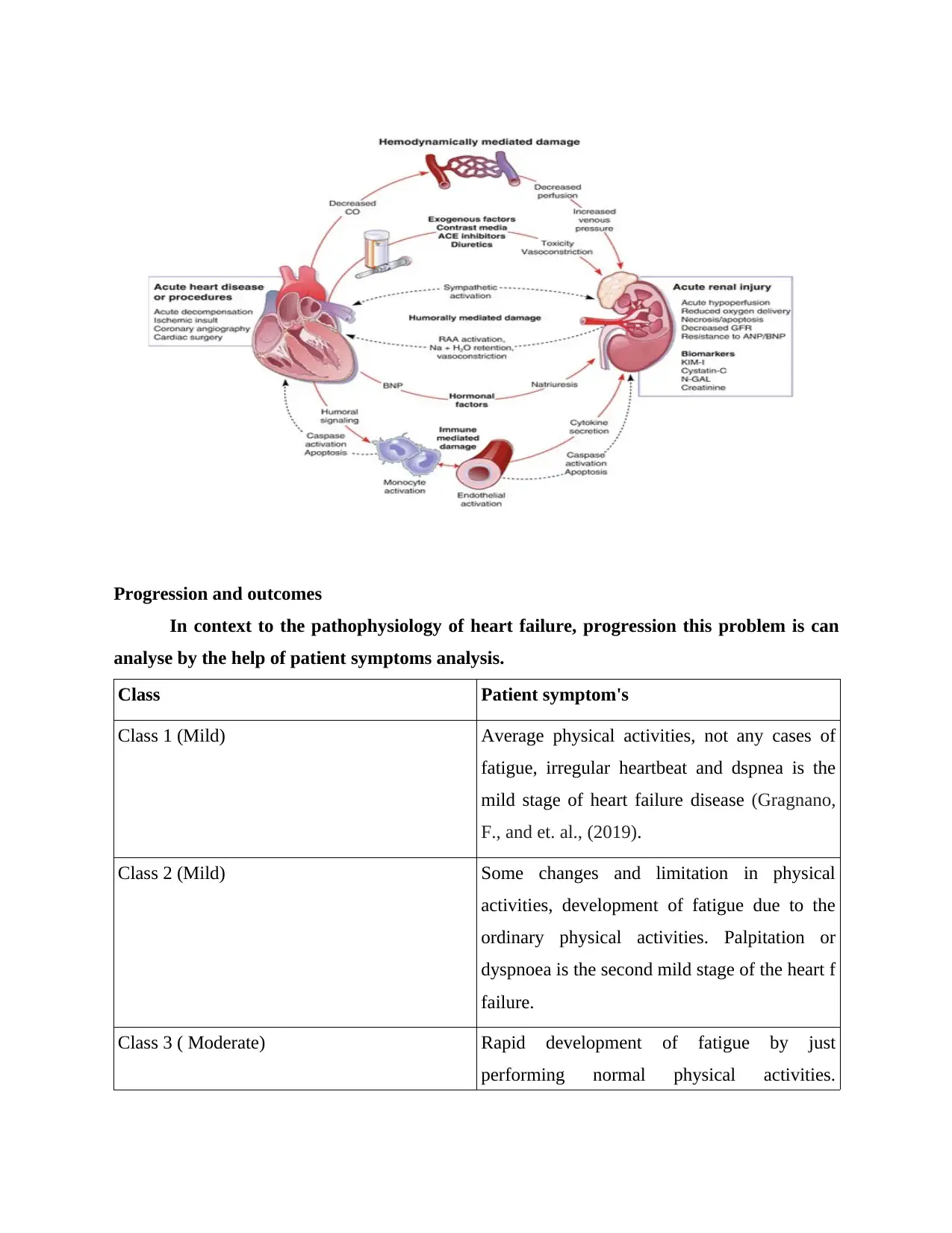
Progression and outcomes
In context to the pathophysiology of heart failure, progression this problem is can
analyse by the help of patient symptoms analysis.
Class Patient symptom's
Class 1 (Mild) Average physical activities, not any cases of
fatigue, irregular heartbeat and dspnea is the
mild stage of heart failure disease (Gragnano,
F., and et. al., (2019).
Class 2 (Mild) Some changes and limitation in physical
activities, development of fatigue due to the
ordinary physical activities. Palpitation or
dyspnoea is the second mild stage of the heart f
failure.
Class 3 ( Moderate) Rapid development of fatigue by just
performing normal physical activities.
In context to the pathophysiology of heart failure, progression this problem is can
analyse by the help of patient symptoms analysis.
Class Patient symptom's
Class 1 (Mild) Average physical activities, not any cases of
fatigue, irregular heartbeat and dspnea is the
mild stage of heart failure disease (Gragnano,
F., and et. al., (2019).
Class 2 (Mild) Some changes and limitation in physical
activities, development of fatigue due to the
ordinary physical activities. Palpitation or
dyspnoea is the second mild stage of the heart f
failure.
Class 3 ( Moderate) Rapid development of fatigue by just
performing normal physical activities.
Paraphrase This Document
Need a fresh take? Get an instant paraphrase of this document with our AI Paraphraser
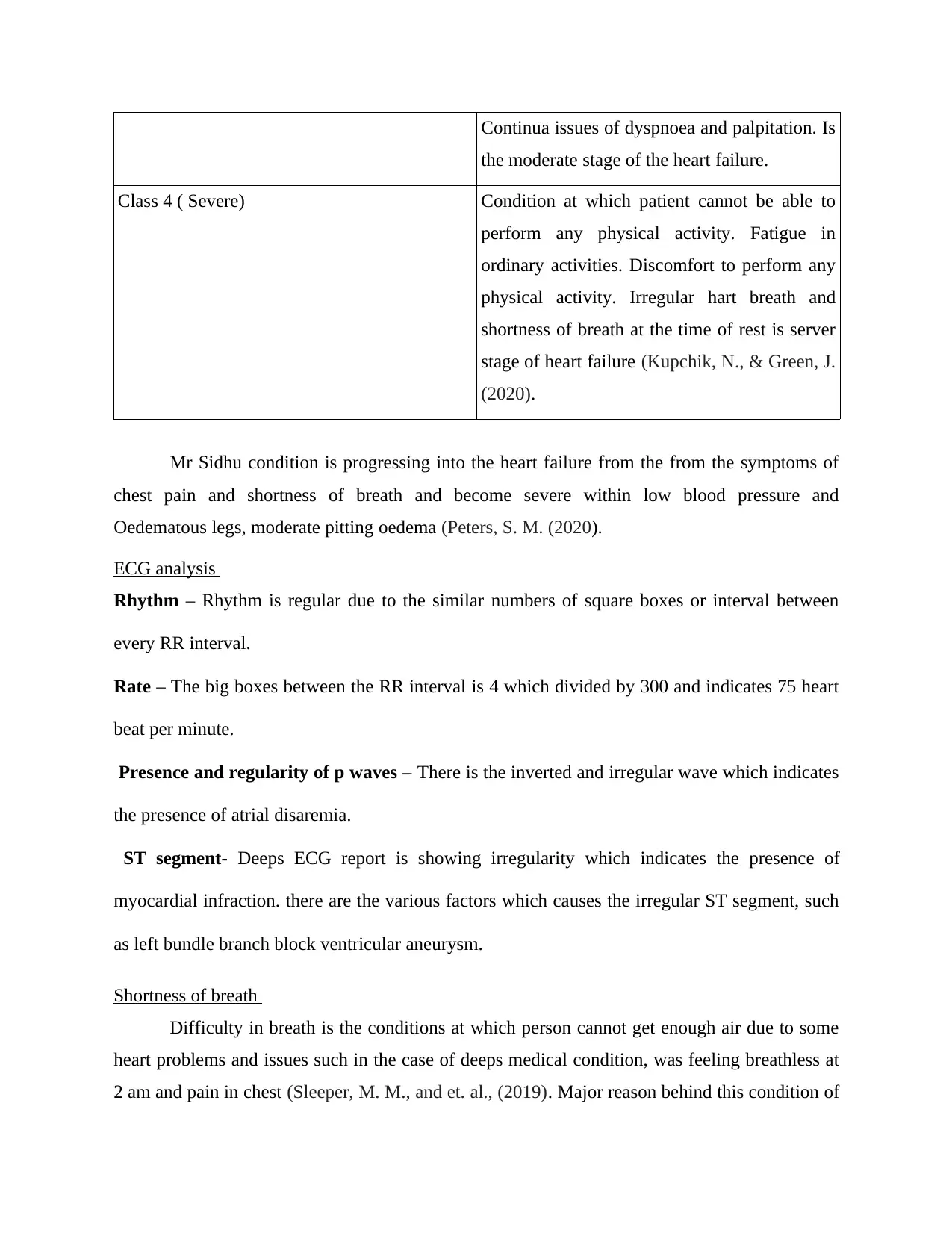
Continua issues of dyspnoea and palpitation. Is
the moderate stage of the heart failure.
Class 4 ( Severe) Condition at which patient cannot be able to
perform any physical activity. Fatigue in
ordinary activities. Discomfort to perform any
physical activity. Irregular hart breath and
shortness of breath at the time of rest is server
stage of heart failure (Kupchik, N., & Green, J.
(2020).
Mr Sidhu condition is progressing into the heart failure from the from the symptoms of
chest pain and shortness of breath and become severe within low blood pressure and
Oedematous legs, moderate pitting oedema (Peters, S. M. (2020).
ECG analysis
Rhythm – Rhythm is regular due to the similar numbers of square boxes or interval between
every RR interval.
Rate – The big boxes between the RR interval is 4 which divided by 300 and indicates 75 heart
beat per minute.
Presence and regularity of p waves – There is the inverted and irregular wave which indicates
the presence of atrial disaremia.
ST segment- Deeps ECG report is showing irregularity which indicates the presence of
myocardial infraction. there are the various factors which causes the irregular ST segment, such
as left bundle branch block ventricular aneurysm.
Shortness of breath
Difficulty in breath is the conditions at which person cannot get enough air due to some
heart problems and issues such in the case of deeps medical condition, was feeling breathless at
2 am and pain in chest (Sleeper, M. M., and et. al., (2019). Major reason behind this condition of
the moderate stage of the heart failure.
Class 4 ( Severe) Condition at which patient cannot be able to
perform any physical activity. Fatigue in
ordinary activities. Discomfort to perform any
physical activity. Irregular hart breath and
shortness of breath at the time of rest is server
stage of heart failure (Kupchik, N., & Green, J.
(2020).
Mr Sidhu condition is progressing into the heart failure from the from the symptoms of
chest pain and shortness of breath and become severe within low blood pressure and
Oedematous legs, moderate pitting oedema (Peters, S. M. (2020).
ECG analysis
Rhythm – Rhythm is regular due to the similar numbers of square boxes or interval between
every RR interval.
Rate – The big boxes between the RR interval is 4 which divided by 300 and indicates 75 heart
beat per minute.
Presence and regularity of p waves – There is the inverted and irregular wave which indicates
the presence of atrial disaremia.
ST segment- Deeps ECG report is showing irregularity which indicates the presence of
myocardial infraction. there are the various factors which causes the irregular ST segment, such
as left bundle branch block ventricular aneurysm.
Shortness of breath
Difficulty in breath is the conditions at which person cannot get enough air due to some
heart problems and issues such in the case of deeps medical condition, was feeling breathless at
2 am and pain in chest (Sleeper, M. M., and et. al., (2019). Major reason behind this condition of
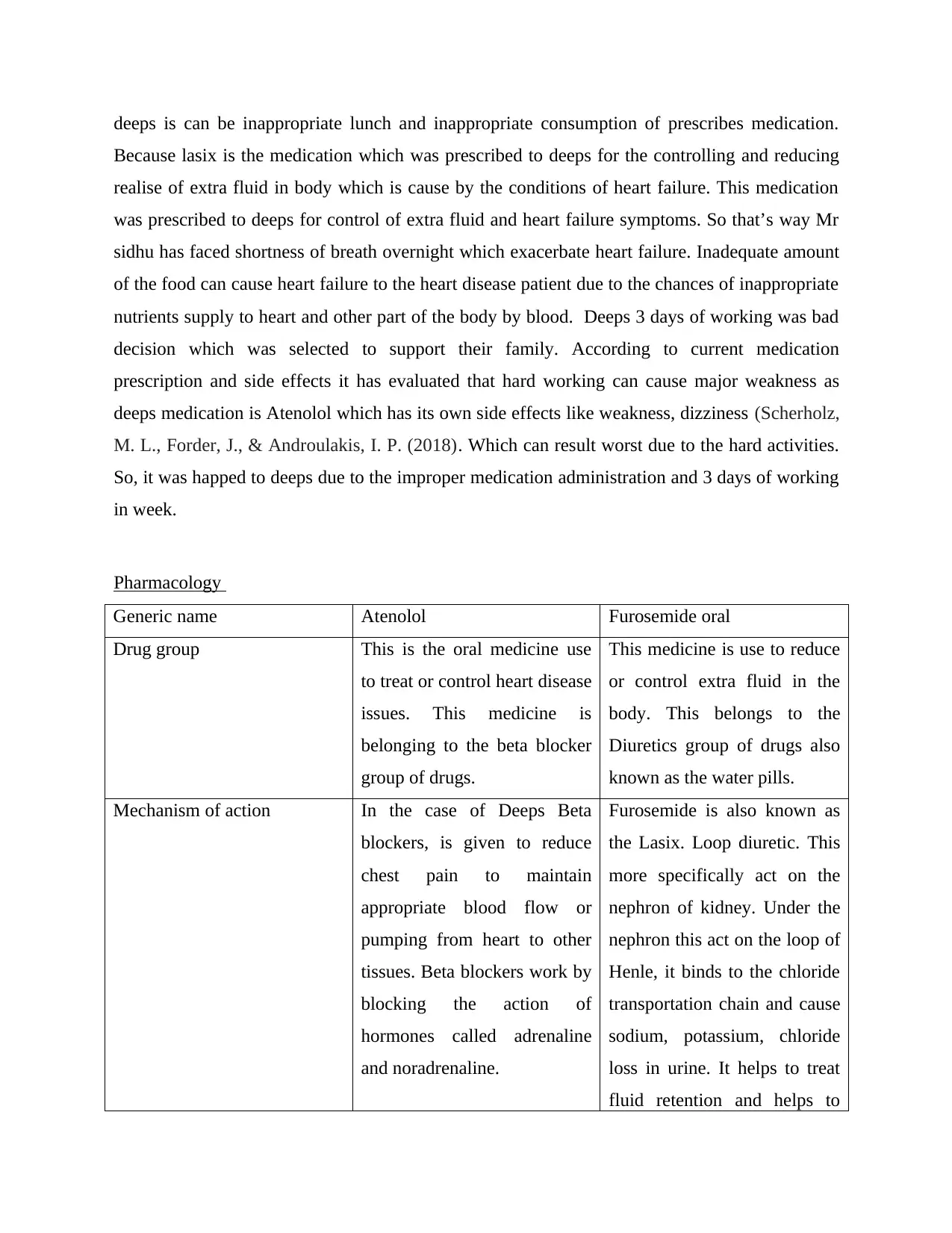
deeps is can be inappropriate lunch and inappropriate consumption of prescribes medication.
Because lasix is the medication which was prescribed to deeps for the controlling and reducing
realise of extra fluid in body which is cause by the conditions of heart failure. This medication
was prescribed to deeps for control of extra fluid and heart failure symptoms. So that’s way Mr
sidhu has faced shortness of breath overnight which exacerbate heart failure. Inadequate amount
of the food can cause heart failure to the heart disease patient due to the chances of inappropriate
nutrients supply to heart and other part of the body by blood. Deeps 3 days of working was bad
decision which was selected to support their family. According to current medication
prescription and side effects it has evaluated that hard working can cause major weakness as
deeps medication is Atenolol which has its own side effects like weakness, dizziness (Scherholz,
M. L., Forder, J., & Androulakis, I. P. (2018). Which can result worst due to the hard activities.
So, it was happed to deeps due to the improper medication administration and 3 days of working
in week.
Pharmacology
Generic name Atenolol Furosemide oral
Drug group This is the oral medicine use
to treat or control heart disease
issues. This medicine is
belonging to the beta blocker
group of drugs.
This medicine is use to reduce
or control extra fluid in the
body. This belongs to the
Diuretics group of drugs also
known as the water pills.
Mechanism of action In the case of Deeps Beta
blockers, is given to reduce
chest pain to maintain
appropriate blood flow or
pumping from heart to other
tissues. Beta blockers work by
blocking the action of
hormones called adrenaline
and noradrenaline.
Furosemide is also known as
the Lasix. Loop diuretic. This
more specifically act on the
nephron of kidney. Under the
nephron this act on the loop of
Henle, it binds to the chloride
transportation chain and cause
sodium, potassium, chloride
loss in urine. It helps to treat
fluid retention and helps to
Because lasix is the medication which was prescribed to deeps for the controlling and reducing
realise of extra fluid in body which is cause by the conditions of heart failure. This medication
was prescribed to deeps for control of extra fluid and heart failure symptoms. So that’s way Mr
sidhu has faced shortness of breath overnight which exacerbate heart failure. Inadequate amount
of the food can cause heart failure to the heart disease patient due to the chances of inappropriate
nutrients supply to heart and other part of the body by blood. Deeps 3 days of working was bad
decision which was selected to support their family. According to current medication
prescription and side effects it has evaluated that hard working can cause major weakness as
deeps medication is Atenolol which has its own side effects like weakness, dizziness (Scherholz,
M. L., Forder, J., & Androulakis, I. P. (2018). Which can result worst due to the hard activities.
So, it was happed to deeps due to the improper medication administration and 3 days of working
in week.
Pharmacology
Generic name Atenolol Furosemide oral
Drug group This is the oral medicine use
to treat or control heart disease
issues. This medicine is
belonging to the beta blocker
group of drugs.
This medicine is use to reduce
or control extra fluid in the
body. This belongs to the
Diuretics group of drugs also
known as the water pills.
Mechanism of action In the case of Deeps Beta
blockers, is given to reduce
chest pain to maintain
appropriate blood flow or
pumping from heart to other
tissues. Beta blockers work by
blocking the action of
hormones called adrenaline
and noradrenaline.
Furosemide is also known as
the Lasix. Loop diuretic. This
more specifically act on the
nephron of kidney. Under the
nephron this act on the loop of
Henle, it binds to the chloride
transportation chain and cause
sodium, potassium, chloride
loss in urine. It helps to treat
fluid retention and helps to
⊘ This is a preview!⊘
Do you want full access?
Subscribe today to unlock all pages.

Trusted by 1+ million students worldwide
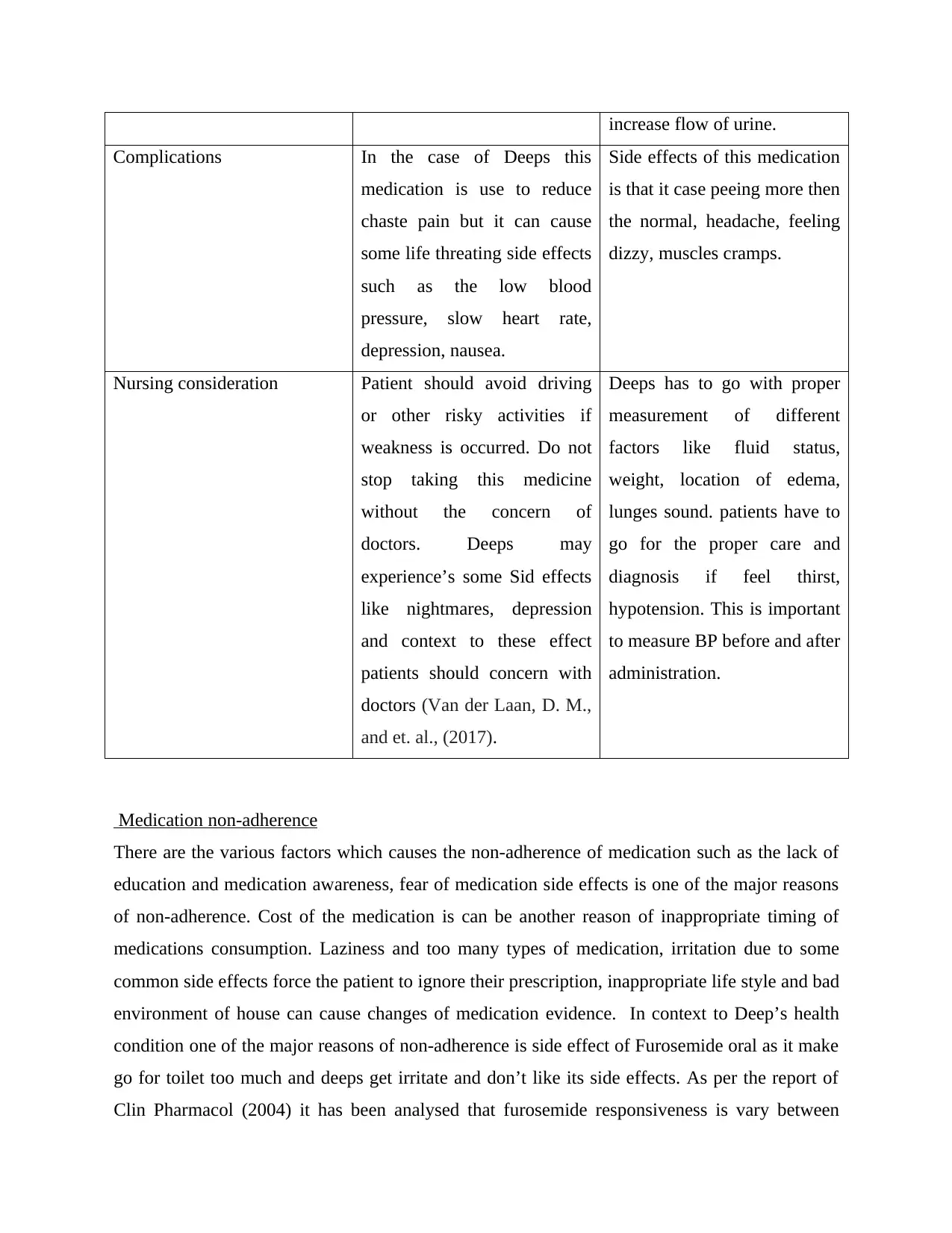
increase flow of urine.
Complications In the case of Deeps this
medication is use to reduce
chaste pain but it can cause
some life threating side effects
such as the low blood
pressure, slow heart rate,
depression, nausea.
Side effects of this medication
is that it case peeing more then
the normal, headache, feeling
dizzy, muscles cramps.
Nursing consideration Patient should avoid driving
or other risky activities if
weakness is occurred. Do not
stop taking this medicine
without the concern of
doctors. Deeps may
experience’s some Sid effects
like nightmares, depression
and context to these effect
patients should concern with
doctors (Van der Laan, D. M.,
and et. al., (2017).
Deeps has to go with proper
measurement of different
factors like fluid status,
weight, location of edema,
lunges sound. patients have to
go for the proper care and
diagnosis if feel thirst,
hypotension. This is important
to measure BP before and after
administration.
Medication non-adherence
There are the various factors which causes the non-adherence of medication such as the lack of
education and medication awareness, fear of medication side effects is one of the major reasons
of non-adherence. Cost of the medication is can be another reason of inappropriate timing of
medications consumption. Laziness and too many types of medication, irritation due to some
common side effects force the patient to ignore their prescription, inappropriate life style and bad
environment of house can cause changes of medication evidence. In context to Deep’s health
condition one of the major reasons of non-adherence is side effect of Furosemide oral as it make
go for toilet too much and deeps get irritate and don’t like its side effects. As per the report of
Clin Pharmacol (2004) it has been analysed that furosemide responsiveness is vary between
Complications In the case of Deeps this
medication is use to reduce
chaste pain but it can cause
some life threating side effects
such as the low blood
pressure, slow heart rate,
depression, nausea.
Side effects of this medication
is that it case peeing more then
the normal, headache, feeling
dizzy, muscles cramps.
Nursing consideration Patient should avoid driving
or other risky activities if
weakness is occurred. Do not
stop taking this medicine
without the concern of
doctors. Deeps may
experience’s some Sid effects
like nightmares, depression
and context to these effect
patients should concern with
doctors (Van der Laan, D. M.,
and et. al., (2017).
Deeps has to go with proper
measurement of different
factors like fluid status,
weight, location of edema,
lunges sound. patients have to
go for the proper care and
diagnosis if feel thirst,
hypotension. This is important
to measure BP before and after
administration.
Medication non-adherence
There are the various factors which causes the non-adherence of medication such as the lack of
education and medication awareness, fear of medication side effects is one of the major reasons
of non-adherence. Cost of the medication is can be another reason of inappropriate timing of
medications consumption. Laziness and too many types of medication, irritation due to some
common side effects force the patient to ignore their prescription, inappropriate life style and bad
environment of house can cause changes of medication evidence. In context to Deep’s health
condition one of the major reasons of non-adherence is side effect of Furosemide oral as it make
go for toilet too much and deeps get irritate and don’t like its side effects. As per the report of
Clin Pharmacol (2004) it has been analysed that furosemide responsiveness is vary between
Paraphrase This Document
Need a fresh take? Get an instant paraphrase of this document with our AI Paraphraser
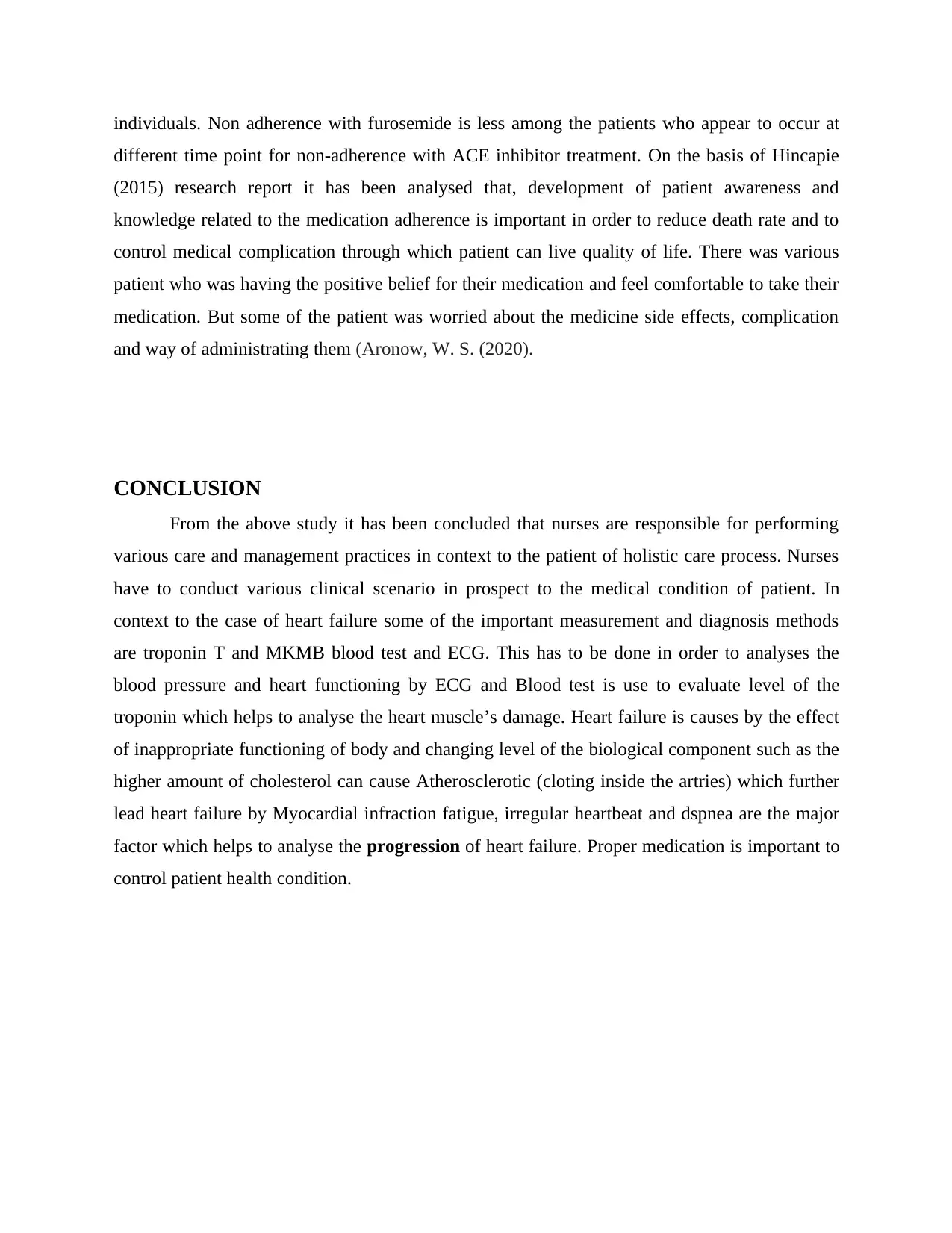
individuals. Non adherence with furosemide is less among the patients who appear to occur at
different time point for non-adherence with ACE inhibitor treatment. On the basis of Hincapie
(2015) research report it has been analysed that, development of patient awareness and
knowledge related to the medication adherence is important in order to reduce death rate and to
control medical complication through which patient can live quality of life. There was various
patient who was having the positive belief for their medication and feel comfortable to take their
medication. But some of the patient was worried about the medicine side effects, complication
and way of administrating them (Aronow, W. S. (2020).
CONCLUSION
From the above study it has been concluded that nurses are responsible for performing
various care and management practices in context to the patient of holistic care process. Nurses
have to conduct various clinical scenario in prospect to the medical condition of patient. In
context to the case of heart failure some of the important measurement and diagnosis methods
are troponin T and MKMB blood test and ECG. This has to be done in order to analyses the
blood pressure and heart functioning by ECG and Blood test is use to evaluate level of the
troponin which helps to analyse the heart muscle’s damage. Heart failure is causes by the effect
of inappropriate functioning of body and changing level of the biological component such as the
higher amount of cholesterol can cause Atherosclerotic (cloting inside the artries) which further
lead heart failure by Myocardial infraction fatigue, irregular heartbeat and dspnea are the major
factor which helps to analyse the progression of heart failure. Proper medication is important to
control patient health condition.
different time point for non-adherence with ACE inhibitor treatment. On the basis of Hincapie
(2015) research report it has been analysed that, development of patient awareness and
knowledge related to the medication adherence is important in order to reduce death rate and to
control medical complication through which patient can live quality of life. There was various
patient who was having the positive belief for their medication and feel comfortable to take their
medication. But some of the patient was worried about the medicine side effects, complication
and way of administrating them (Aronow, W. S. (2020).
CONCLUSION
From the above study it has been concluded that nurses are responsible for performing
various care and management practices in context to the patient of holistic care process. Nurses
have to conduct various clinical scenario in prospect to the medical condition of patient. In
context to the case of heart failure some of the important measurement and diagnosis methods
are troponin T and MKMB blood test and ECG. This has to be done in order to analyses the
blood pressure and heart functioning by ECG and Blood test is use to evaluate level of the
troponin which helps to analyse the heart muscle’s damage. Heart failure is causes by the effect
of inappropriate functioning of body and changing level of the biological component such as the
higher amount of cholesterol can cause Atherosclerotic (cloting inside the artries) which further
lead heart failure by Myocardial infraction fatigue, irregular heartbeat and dspnea are the major
factor which helps to analyse the progression of heart failure. Proper medication is important to
control patient health condition.
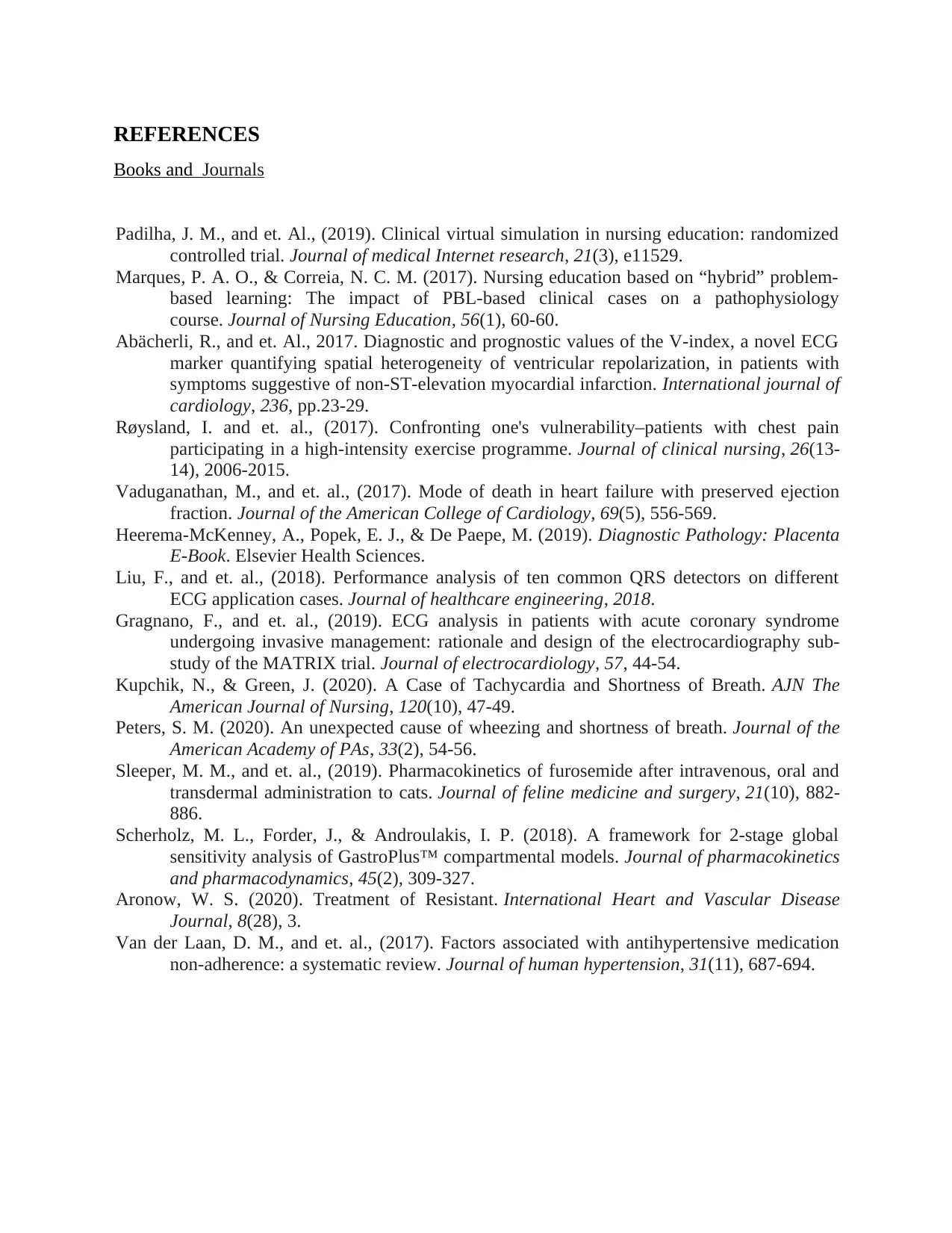
REFERENCES
Books and Journals
Padilha, J. M., and et. Al., (2019). Clinical virtual simulation in nursing education: randomized
controlled trial. Journal of medical Internet research, 21(3), e11529.
Marques, P. A. O., & Correia, N. C. M. (2017). Nursing education based on “hybrid” problem-
based learning: The impact of PBL-based clinical cases on a pathophysiology
course. Journal of Nursing Education, 56(1), 60-60.
Abächerli, R., and et. Al., 2017. Diagnostic and prognostic values of the V-index, a novel ECG
marker quantifying spatial heterogeneity of ventricular repolarization, in patients with
symptoms suggestive of non-ST-elevation myocardial infarction. International journal of
cardiology, 236, pp.23-29.
Røysland, I. and et. al., (2017). Confronting one's vulnerability–patients with chest pain
participating in a high‐intensity exercise programme. Journal of clinical nursing, 26(13-
14), 2006-2015.
Vaduganathan, M., and et. al., (2017). Mode of death in heart failure with preserved ejection
fraction. Journal of the American College of Cardiology, 69(5), 556-569.
Heerema-McKenney, A., Popek, E. J., & De Paepe, M. (2019). Diagnostic Pathology: Placenta
E-Book. Elsevier Health Sciences.
Liu, F., and et. al., (2018). Performance analysis of ten common QRS detectors on different
ECG application cases. Journal of healthcare engineering, 2018.
Gragnano, F., and et. al., (2019). ECG analysis in patients with acute coronary syndrome
undergoing invasive management: rationale and design of the electrocardiography sub-
study of the MATRIX trial. Journal of electrocardiology, 57, 44-54.
Kupchik, N., & Green, J. (2020). A Case of Tachycardia and Shortness of Breath. AJN The
American Journal of Nursing, 120(10), 47-49.
Peters, S. M. (2020). An unexpected cause of wheezing and shortness of breath. Journal of the
American Academy of PAs, 33(2), 54-56.
Sleeper, M. M., and et. al., (2019). Pharmacokinetics of furosemide after intravenous, oral and
transdermal administration to cats. Journal of feline medicine and surgery, 21(10), 882-
886.
Scherholz, M. L., Forder, J., & Androulakis, I. P. (2018). A framework for 2-stage global
sensitivity analysis of GastroPlus™ compartmental models. Journal of pharmacokinetics
and pharmacodynamics, 45(2), 309-327.
Aronow, W. S. (2020). Treatment of Resistant. International Heart and Vascular Disease
Journal, 8(28), 3.
Van der Laan, D. M., and et. al., (2017). Factors associated with antihypertensive medication
non-adherence: a systematic review. Journal of human hypertension, 31(11), 687-694.
Books and Journals
Padilha, J. M., and et. Al., (2019). Clinical virtual simulation in nursing education: randomized
controlled trial. Journal of medical Internet research, 21(3), e11529.
Marques, P. A. O., & Correia, N. C. M. (2017). Nursing education based on “hybrid” problem-
based learning: The impact of PBL-based clinical cases on a pathophysiology
course. Journal of Nursing Education, 56(1), 60-60.
Abächerli, R., and et. Al., 2017. Diagnostic and prognostic values of the V-index, a novel ECG
marker quantifying spatial heterogeneity of ventricular repolarization, in patients with
symptoms suggestive of non-ST-elevation myocardial infarction. International journal of
cardiology, 236, pp.23-29.
Røysland, I. and et. al., (2017). Confronting one's vulnerability–patients with chest pain
participating in a high‐intensity exercise programme. Journal of clinical nursing, 26(13-
14), 2006-2015.
Vaduganathan, M., and et. al., (2017). Mode of death in heart failure with preserved ejection
fraction. Journal of the American College of Cardiology, 69(5), 556-569.
Heerema-McKenney, A., Popek, E. J., & De Paepe, M. (2019). Diagnostic Pathology: Placenta
E-Book. Elsevier Health Sciences.
Liu, F., and et. al., (2018). Performance analysis of ten common QRS detectors on different
ECG application cases. Journal of healthcare engineering, 2018.
Gragnano, F., and et. al., (2019). ECG analysis in patients with acute coronary syndrome
undergoing invasive management: rationale and design of the electrocardiography sub-
study of the MATRIX trial. Journal of electrocardiology, 57, 44-54.
Kupchik, N., & Green, J. (2020). A Case of Tachycardia and Shortness of Breath. AJN The
American Journal of Nursing, 120(10), 47-49.
Peters, S. M. (2020). An unexpected cause of wheezing and shortness of breath. Journal of the
American Academy of PAs, 33(2), 54-56.
Sleeper, M. M., and et. al., (2019). Pharmacokinetics of furosemide after intravenous, oral and
transdermal administration to cats. Journal of feline medicine and surgery, 21(10), 882-
886.
Scherholz, M. L., Forder, J., & Androulakis, I. P. (2018). A framework for 2-stage global
sensitivity analysis of GastroPlus™ compartmental models. Journal of pharmacokinetics
and pharmacodynamics, 45(2), 309-327.
Aronow, W. S. (2020). Treatment of Resistant. International Heart and Vascular Disease
Journal, 8(28), 3.
Van der Laan, D. M., and et. al., (2017). Factors associated with antihypertensive medication
non-adherence: a systematic review. Journal of human hypertension, 31(11), 687-694.
⊘ This is a preview!⊘
Do you want full access?
Subscribe today to unlock all pages.

Trusted by 1+ million students worldwide
1 out of 12
Related Documents
Your All-in-One AI-Powered Toolkit for Academic Success.
+13062052269
info@desklib.com
Available 24*7 on WhatsApp / Email
![[object Object]](/_next/static/media/star-bottom.7253800d.svg)
Unlock your academic potential
Copyright © 2020–2025 A2Z Services. All Rights Reserved. Developed and managed by ZUCOL.





